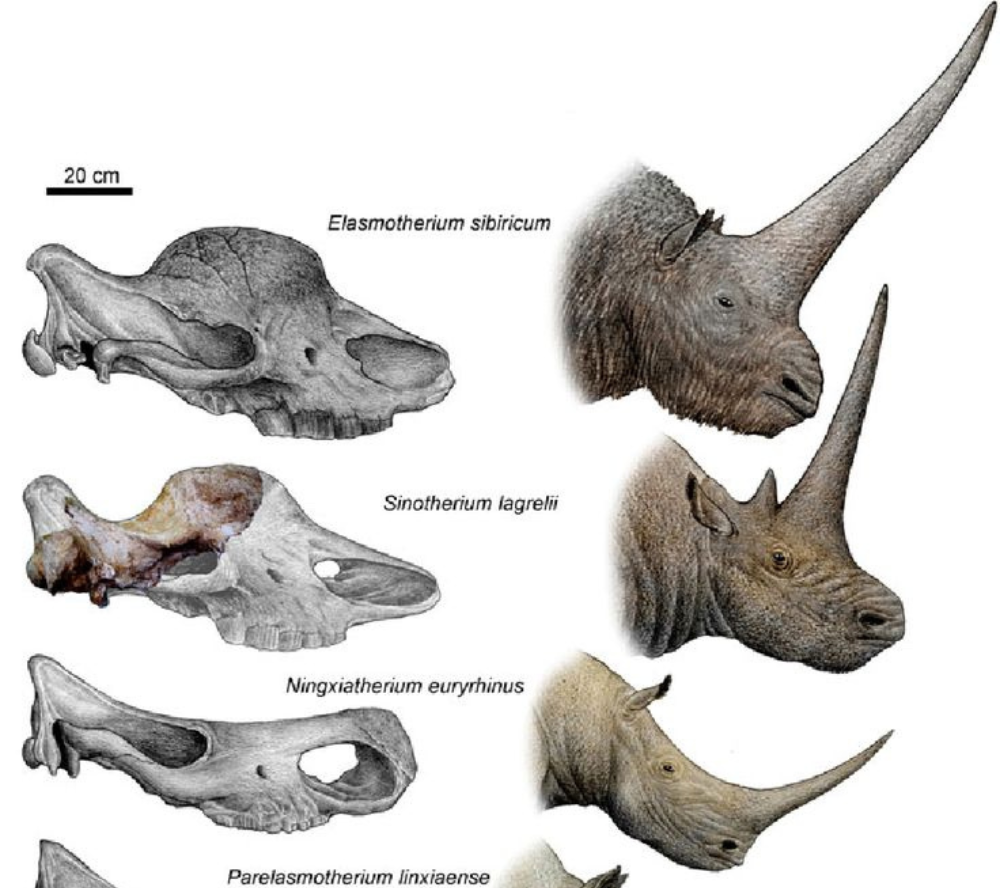
This fascinating comparative image shows skulls and artistic reconstructions of various extinct rhinoceros species, many of which belonged to a unique subfamily called Elasmotheriinae, often referred to as the “giant rhinos” or sometimes “unicorn rhinos” due to the prominent horn structure inferred from their skulls.
Here’s a breakdown of the species shown in the image, from top to bottom:
🦏 1. Elasmotherium sibiricum
- Era: Late Pleistocene (approx. 2.6 million – 29,000 years ago)
- Region: Eurasia (especially Russia and Central Asia)
- Notable Feature: Massive horn on the forehead, possibly over 1.5 meters long.
- Nicknamed: The “Siberian unicorn”
- Size: Comparable to a modern-day elephant
- Ecology: Grazing herbivore on the mammoth steppe
🦏 2. Sinotherium lagrelii
- Era: Miocene to early Pliocene
- Region: Asia (notably China)
- Feature: Robust horn base on the nasal area, indicating a thick, forward-tilting horn.
- Transitional Form: Bridges features between more archaic forms and the massive Elasmotherium.
🦏 3. Ningxiatherium euryhinus
- Era: Miocene
- Region: China
- Feature: Long, narrow snout with a horn that may have tilted dramatically forward.
- Specialization: Possibly adapted to more specific feeding habits based on the skull shape.
🦏 4. Parelasmotherium linxiaense
- Era: Miocene
- Region: China
- Feature: Similar skull structure to Ningxiatherium but slightly different nasal arch.
- Smaller Horn Base: Indicates smaller horn compared to its relatives.
🦏 5. Iranotherium morgani
- Era: Late Miocene
- Region: Iran and Central Asia
- Feature: Elongated skull and horn base.
- Ecological Role: Likely a grazer, thriving in open habitats.
🦏 6. Hispanotherium tungurense
- Era: Miocene
- Region: Iberian Peninsula and parts of Asia
- Feature: Smaller horn, robust skull.
- Basal Member: One of the earlier Elasmotheriine genera.
📏 Scale and Evolution
- The 20 cm scale bar at the top left helps highlight the massive size variation in skulls.
- The image provides a clear evolutionary timeline, from more primitive forms (Hispanotherium) to highly specialized giants (Elasmotherium).
- Skull morphology and horn orientation shifted dramatically, likely in response to changing environments, diets, and ecological pressures.
🦴 Why the Interest in Elasmotheriines?
These animals showcase some of the most extreme adaptations in rhinoceros evolution:
- Their forehead horns, unlike modern rhinos, sat over the frontal bone rather than the nasal bone.
- Their large size and thick limbs hint at a terrestrial, steppe-dwelling lifestyle.
- There’s even some speculation in folklore that they inspired early “unicorn” legends.
Would you like a timeline of their evolution or comparisons with modern rhinos next?




